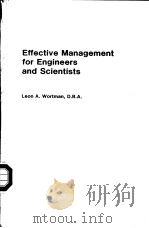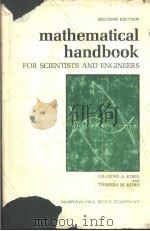《MATHEMATICAL HANDBOOK FOR SCIENTISTS AND ENGINEERS KORN and KORN》
| 作者 | 编者 |
|---|---|
| 出版 | 未查询到或未知 |
| 参考页数 | 943 |
| 出版时间 | 没有确切时间的资料 目录预览 |
| ISBN号 | 无 — 求助条款 |
| PDF编号 | 811298818(仅供预览,未存储实际文件) |
| 求助格式 | 扫描PDF(若分多册发行,每次仅能受理1册) |
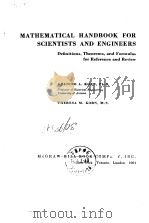
Chapter 1.Real and Complex Numbers.Elementary Algebra1
1.1.Introduction.The Real-number System2
1.2.Powers,Roots,Logarithms,and Factorials.Sum and Product Notation4
1.3.Complex Numbers7
1.4.Miscellaneous Formulas10
1.5.Determinants12
1.6.Algebraic Equations:General Theorems15
1.7.Factoring of Polynomials and Quotients of Polynomials.Partial Frac-tions19
1.8.Linear,Quadratic,Cubic,and Quartic Equations22
1.9.Systems of Simultaneous Equations24
1.10.Related Topics,References,and Bibliography27
Chapter 2.Plane Analytic Geometry28
2.1.Introduction and Basic Concepts29
2.2.The Straight Line35
2.3.Relations Involving Points and Straight Lines37
2.4.Second-order Curves(Conic Sections)39
2.5.Properties of Circles,Ellipses,Hyperbolas and Parabolas46
2.6.Higher Plane Curves51
2.7.Related Topics,References,and Bibliography52
Chapter 3.Solid Analytic Geometry54
3.1.Introduction and Basic Concepts55
3.2.The Plane64
3.3.The Straight Line66
3.4.Relations Involving Points,Planes,and Straight Lines67
3.5.Quadric Surfaces71
3.6.Related Topics,References,and Bibliography79
Chapter 4.Funetions and Limits.Differential and Integral Caleulus80
4.1.Introduction82
4.2.Functions82
4.3.Point Sets,Intervals,and Regions84
4.4.Limits,Continuous Functions,and Related Topics87
4.5.Differential Caiculus92
4.6.Integrals and Integration99
4.7.Mean-value Theorems.Values of indeterminate Forms.Weierstrass's Approximation Theorems115
4.8.Infinite Series,Infnite Products,and Continued Fractions118
4.9.Tests for the Convergence and Uniform Convergence of Infinite Series and Improper Integrals124
4.10.Representation of Functions by Infinite Series and Integrals.Power Series and Taylor's Expansion128
4.11.Fourier Series and Fourier Integrals131
4.12.Related Topics,References,and Bibliography140
Chapter 5.Vector Analysis141
5.1.Introduction142
5.2.Vector Algebra143
5.3.Vector Calculus:Functions of a Scalar Parameter147
5.4.Scalar and Vector Fields149
5.5.Differential Operators153
5.6.Integral Theorems158
5.7.Specification of a Vector Field in Terms of Its Curl and Divergence160
5.8.Related Topics,References,and Bibliography162
Chapter 6.Curvilinear Coordinate Systems164
6.1.Introduction164
6.2.Curvilinear Coordinate Systems165
6.3.Representation of Vectors in Terms of Components167
6.4.Orthogonal Coordinate Systems.Vector Relations in Terms of Orthog-onal Components169
6.5.Formulas Relating to Special Orthogonal Coordinate Systems181
6.6.Related Topics,References,and Bibliography182
Chapter 7.Functions of a Complex Variable183
7.1.Introduction184
7.2.Functions of a Complex Variable.Regions of the Complex-number Plane184
7.3.Analytic(Regular,Holomorphic)Functions188
7.4.Treatment of Multiple-valued Functions189
7.5.Integral Theorems and Series Expansions191
7.6.Zeros and Isolated Singularities193
7.7.Residues and Contour Integration197
7.8.Analytic Continuation199
7.9.Conformal Mapping200
7.10.Functions Mapping Specified Regions onto the Unit Circle213
7.11.Related Topics,References,and Bibliography213
Chapter 8.The Laplace Transformation and Other Integral Transformations215
8.1.Introduction216
8.2.The Laplace Transformation216
8.3.Correspondence between Operations on Object and Result Functions219
8.4.Tables of Laplace-transform Pairs and Computation of Inverse Laplace Transforms222
8.5."Formal"Laplace Transformation of Impulse-function Terms227
8.6.Some Other Functional Transformations227
8.7.Related Topics,References,and Bibliography231
Chapter 9.Ordinary Differential Equations233
9.1.Introduction234
9.2.First-order Equations237
9.3.Linear Differential Equations242
9.4.Linear Differential Equations with Constant Coefficients253
9.5.Nonlinear Second-order Equations264
9.6.Pfaffian Differential Equations270
9.7.Related Topics,References,and Bibliography272
Chapter 10.Partial Differential Equations273
10.1.Introduction and Survey274
10.2.Partial Differential Equations of the First Order276
10.3.Hyperbolic,Parabolic,and Elliptic Partial Differential Equations.Characteristics288
10.4.Linear Partial Differential Equations of Physics.Particular Solutions297
10.5.Integral-transform Methods310
10.6.Related Topics,References,and Bibliography314
Chapter 11.Maxima and Minima315
11.1.Introduction316
11.2.Maxima and Minima(Extreme Values)of Functions of One Real Variable316
11.3.Maxima and Minima(Extreme Values)of Functions of Two or More Real Variables317
11.4.Calculus of Variations.Maxima and Minima of Definite Integrals320
11.5.Solution of Variation Problems in Terms of Differential Equations322
11.6.Solution of Variation Problems by Dircct Methods328
11.7.Related Topics,Rcferences,and Bibliography329
Chapter 12.Definition of Mathematical Models:Modern(Abstract)Alsebra and Abstract Spaces331
12.1.Introduction332
12.2.Algebra of Models with a Single Defining Operation:Groups336
12.3.Algebra of Models with Two Defining Operations:Rings,Fields,and Inte-gral Domains340
12.4.Models Involving More Than One Class of Mathematical Objects:Linear Vector Spaces and Linear Algebras342
12.5.Models Permitting the Definition of Limiting Processes:Topological Spaces344
12.6.Order347
12.7.Combination of Models:Direct Products,Product Spaces,and Direct Sums348
12.8.Boolean Algebras350
12.9.Related Topics,References,and Bibliography353
Chapter 13.Matrices.Quadratic and Hermitian Forms355
13.1.Introduction356
13.2.Matrix Algebra and Matrix Calculus356
13.3.Matrices with Special Symmetry Properties362
13.4.Equivalent Matrices.Eigenvalues,Diagonalization,and Related Topics364
13.5.Quadratic and Hermitian Forms368
13.6.Related Topics,References,and Bibliography372
Chapter 14.Linear Vector Spaces and Linear Transformations(Linear Operators).Representation of Mathematical Models in Terms of Matrices374
14.1.Introduction.Reference Systems and Coordinate Transformations376
14.2.Linear Vector Spaces378
14.3.Linear Transformations(Linear Operators)382
14.4.Linear Transformations of a Normed or Unitary Vector Space into Itself.Hermitian and Unitary Transformations(Operators)384
14.5.Matrix Representation of Vectors and Linear Transformations(Opera-tors)388
14.6.Change of Reference System390
14.7.Representation of Inner Products.Orthonormal Bases392
14.8.Eigenveetors and Eigenvalues of Linear Operators396
14.9.Group Representations and Related Topics406
14.10.Mathematical Description of Rotations411
14.11.Reiated Topics,References,and Bibliography418
Chapter 15.Linear Integral Equations,Boundary-value Problems,and Eigenvalue Problems420
15.1.Introdnetion422
15.2.Functions as Vectors.Expansions in Terms of Orthogonal Functions423
15.3.Linear Integral Transformations and Linear Integral Equations428
15.4.Linear Boundary-value Problems and Eigenvalue Problems Involving Differential Equations438
15.5.Green's Functions.Relation of Boundary-value Problems and Eigen-value Problems to Integral Equations451
15.6.Potential Theory456
15.7.Related Topics,References,and Bibliography467
Chapter 16.Representation of Mathematical Models:Tensor Algebra and Analysis469
16.1.Introduction470
16.2.Absolute and Relative Tensors473
16.3.Tensor Algebra:Definition of Basic Operations476
16.4.Tensor Algebra:Invariance of Tensor Equations479
16.5.Symmetric and Skew-symmetric Tensors479
16.6.Local Systems of Base Vectors481
16.7.Tensors Defined on Riemann Spaces.Associated Tensors482
16.8.Scalar Products and Related Topics485
16.9.Tensors of Rank Two(Dyadics)Defined on Riemann Spaces487
16.10.The Absolute Differential Calculus.Covariant Differentiation488
16.11.Related Topics,References,and Bibliography496
Chapter 17.Differential Geometry497
17.1.Curves in the Euclidean Piane498
17.2.Curves in Three-dimensional Euclidean Space501
17.3.Surfaces in Three-dimensional Euclidean Space505
17.4.Curved Spaces515
17.5.Related Topics,References,and Bibliography520
Chapter 18.Probability Theory and Random Processes521
18.1.Introduction523
18.2.Definition and Representation of Probability Models524
18.3.One-dimensional Probability Distributions529
18.4.Multidimensional Probability Distributions538
18.5.Functions of Random Variables.Change of Variables550
18.6.Convergence in Probability and Limit Theorems554
18.7.Special Techniques for Solving Probability Problems557
18.8.Special Probability Distributions559
18.9.Description of Random Processes571
18.10.Generalized Fourier Analysis for Stationary Random Processes.Corre-lation Functions and Spectra577
18.11.Examples of Random Processes583
18.12.Related Topics,References,and Bibliography585
Chapter 19.Mathematical Statistics587
19.1.Introduction to Statistical Methods588
19.2.Statistical Description.Definition and Computation of Random-sample Statistics591
19.3.General-purpose Probability Distributions597
19.4.Estimation of Parameters599
19.5.Sampling Distributions603
19.6.Tests of Statistical Hypotheses609
19.7.Some Statistics,Sampling Distributions,and Tests for Multivariate Dis-tributions619
19.8.Related Topics,References,and Bibliography626
Chapter 20.Numerical Calculations and Finite Differences627
20.1.Introduction629
20.2.Numerical Solution of Equations630
20.3.Linear Simultaneous Equations and Matrix Inversion.Eigenvalues and Eigenvectors of Matrices635
20.4.Finite Differences and Difference Equations641
20.5.Polynomial Interpolation,Numerical Harmonic Analysis,and Other Approximation Methods650
20.6.Numerical Differentiation and Integration662
20.7.Numerical Solution of Ordinary Differential Equations666
20.8.Numerical Solution of Partial Differential Equations,Boundary-value Problems,and Integral Equations671
20.9.Related Topics,References,and Bibliography680
Chapter 21.Special Functions682
21.1.Introduction684
21.2.The Elementary Transcendental Functions684
21.3.Some Functions Defined by Transcendental Integrals695
21.4.The Gamma Function and Related Functions697
21.5.Binomial Coefficients and Factorial Polynomials.Bernoulli Polynomials and Bernoulli Numbers700
21.6.Elliptic Functions,Elliptic Integrals,and Related Functions703
21.7.Orthogonal Polynomials722
21.8.Cylinder Functions,Associated Legendre Functions,and Spherical Har-monics727
21.9.Step Functions and Symbolic Impulse Functions740
21.10.References and Bibliography746
Appendix A.Formulas Describing Plane Figures and Solids747
Appendix B.Plane and Spherical Trigonometry751
Appendix C.Permutations,Combinations,and Related Topics760
Appendix D.Tables of Fourier Expansions and Laplace-transform Pairs763
Appendix E.Tables of indefinite and Definite Integrals787
Appendix F.Numerical Tables827
Squares828
Logarithms831
Trigonometric Functions848
Exponential and Hyperbolic Functions856
Natural Logarithms863
Sine Integral865
Cosine Integral866
Exponential and Related Integrals867
Complete Elliptie Integrals871
Factorials and Their Reciprocals872
Binomial Coefficients872
Gamma and Factorial Functions873
Bessel Functions875
Legendre Polynomials898
Error Function899
Normal-distribution Areas900
Normal-curve Ordinates901
Distribution of t902
Distribution of x2903
Distribution of F904
Glossary of Symbols and Notations909
Index915
《MATHEMATICAL HANDBOOK FOR SCIENTISTS AND ENGINEERS KORN and KORN》由于是年代较久的资料都绝版了,几乎不可能购买到实物。如果大家为了学习确实需要,可向博主求助其电子版PDF文件。对合法合规的求助,我会当即受理并将下载地址发送给你。
高度相关资料
-

- C FOR SCIENTISTS AND ENGINEERS
- 1997 PRENTICE HALL
-

- MATHEMATICAL METHODS FOR SCIENTISTS AND ENGINEERS
- A WILEY INTERSCIENCE PUBLICATION
-
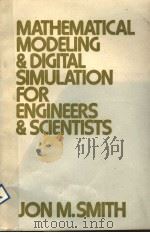
- MATHEMATICAL MODELING AND DIGITAL SIMULATION FOR ENGINEERS AND SCIENTISTS
- JOHN WILEY AND SONS
-

- Geostatistics for engineers and earth scientists
- 1999 Kluwer Academic Publishers
-

- C++ FOR ENGINEERS AND SCIENTISTS
- 1998 PWS PUBLISHING
-
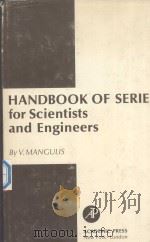
- Handbook of series for scientists and engineers
- 1965 Academic Press
-
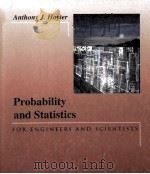
- PROBABILITY AND STATISTICS FOR ENGINEERS AND SCIENTISTS
- 1996 PWS PUBLISHING COMPANY
-

- BASIC ELECTRONICS FOR ENGINEERS AND SCIENTISTS
- 1972 INTEXT EDUCATIONAL PUBLISHERS
-

- APPLIED MATHEMATICS FOR ENGINEERS AND SCIENTISTS
- 1958 THE ENGLISH UNIVERSITIES PRESS LTD
-

- PHYSICS FOR SCIENTISTS AND ENGINEERS
- 1982 PRENTICE-HALL
-

- CHEMISTRY FOR ENGINEERS AND SCIENTISTS
- 1990 SAUNDERS COLLEGE PUBLISHING
提示:百度云已更名为百度网盘(百度盘),天翼云盘、微盘下载地址……暂未提供。➥ PDF文字可复制化或转WORD

